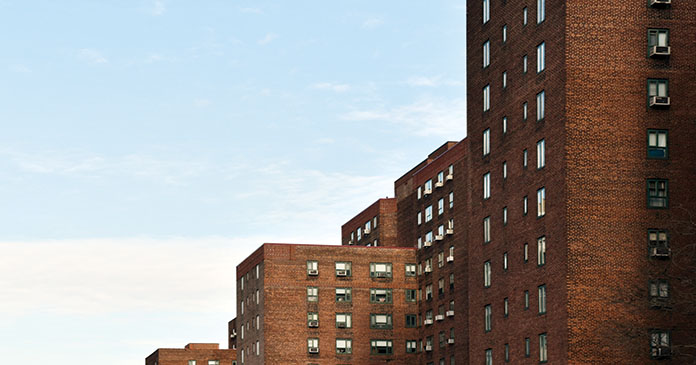On Halloween, 2022, some elected officials held a performative press conference to talk about “Zombie Apartments.” They claim property owners are engaging in a mass conspiracy to keep rent-stabilized apartments vacant in an attempt to manipulate the housing market. The accusation is complete nonsense. Let’s talk about what is really happening.
For over 50 years the Rent Stabilization Law has been in place, in various forms. The goal of the law, when it was originally passed, was to protect against price gouging, while making sure that property owners made a reasonable return on their investment. In 2019, the state legislature and Gov. Andrew Cuomo changed the intent of the law. They no longer cared about making sure property owners got a reasonable return to keep their businesses operating and housing well maintained. The new law was designed to protect tenants currently in occupancy at all costs.
The Community Service Society issued a report in November explicitly stating their goal. They specifically say, in their fourth pathway to social housing, that the government passed HSTPA with the goal of reducing the property value so that non-profit operators can purchase the buildings. They see the massive devaluation and deterioration of rent-stabilized buildings as an opportunity for the government to confiscate the properties.
The reason the buildings saw their value decline is directly tied to the reason there are so many vacant apartments. The law implemented a de facto vacancy control on these units, a regulation that exists nowhere else in the country but New York. When a tenant leaves an apartment, the rent cannot change in that apartment.
At the time the law was passed, there were an estimated 400,000 apartments that had been occupied for more than 20 years, which means they likely need significant financial investment to ensure they are compliant with dozens of local law mandates passed in recent years, including energy efficiency standards and lead abatement.
Using simple math, we can calculate that at least 500 rent-stabilized apartments with long-term tenancies become vacant each month. The 2021 Housing and Vacancy Survey suggests that number likely accelerated during the COVID-19 emergency, leading to a number of 42,860 rent-stabilized apartments being listed as vacant and unavailable for rent.
These apartments need massive renovations when the current tenant moves out. They must comply with lead paint laws passed in 2004 and 2019, which means replacing all the doors and windows, if not completely removing the walls and potentially the ceiling. The electrical wiring needs to be completely re-done, which the state Division of Housing and Community Renewal (HCR) said costs more than $15,000, before inflation took off. Plumbing in buildings that average 80 years old needs to be replaced as well. Quickly the costs for renovating vacant apartments can approach $100,000.
The apartments that need the most renovation work have the lowest rents. These ultra low rents typically don’t cover the operating costs for the apartment, which the New York City Rent Guidelines Board said is $997 a month. Owners have no way to increase those rents. Most rational New Yorkers would not spend six figures on renovating an apartment knowing that they would never get that money back. Most of the small property owners we represent wouldn’t even have the money available to them to do the renovation work without taking out a loan. Banks will not lend to do the work on the apartment if the current rent wouldn’t pay back the loan. The result? The much needed unit of housing sits vacant.
The consequence of this policy change has not helped one tenant. When there is less supply of housing, renters are forced to live in overcrowded apartments, or overpay for apartments that are not rent regulated. Rent stabilization is affordability without subsidy. There is no tax credit or financial offset for an owner who runs a rent stabilized property. The affordability of rent stabilization comes from another renter paying more to cover the below market rents. That is why our organization is asking the state legislature for a vacancy reset on apartments that need legally mandated renovations.
What is a vacancy reset? It would let the owner fix up the vacant unit to code and then rent it out at an affordable rent comparable to nearby apartments. There is already a process for this to happen for the small number of apartments that are still under rent control. When those units become vacant, the owner can fix them up and set a new first rent. That new first rent is subject to a Fair Market Appeal by the first tenant to move into the apartment.
What’s great about a vacancy reset is that it doesn’t raise the rent one cent on existing tenants. It also doesn’t cost the government a dime. In fact, CHIP estimates that it would create roughly $100 million in added tax revenue for New York City next year. That money would help the city build a better social safety net to protect the city’s most vulnerable. Plus, the new apartments would help the housing crunch and reduce homelessness.
Author Jay Martin is executive director of the Community Housing Improvement Program in the New York City metropolitan area
update: On May 2, 2023, the Rent Guidelines Board approved a range of increases for the city’s 1 million stabilized tenants. By a 5-4 vote, the board approved a preliminary range of increases of 2-5 percent for one-year leases and 4-7 percent for two-year leases. The Board will vote on the final percentage increase on June 21, but increases historically fall within the preliminary range. Landlord representatives had sought increases as high as 14 percent, while the tenant members were hoping for a rent rollback of -1 percent.
The Closer is a forum for provocative thought relating to the multifamily housing industry. The views herein do not necessarily reflect those of the magazine.















